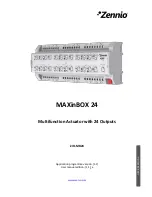
micro
HAM ©
2016
All rights reserved
CAT (RADIO) & 2
nd
CAT PORT
The CAT channel is used by the host application to control transceiver frequency, mode, and many other
parameters. The application communicates with the radio using a serial protocol. Although most modern radios
implement some form of serial control, nearly every radio implementation is different. The degree of control
available for each radio depends on that radio and the application (logger or digital program).
NOTE:
The COM port number assigned in Router MUST match the port number assigned in the host
application. First configure the virtual COM ports in Router then configure the application.
When a COM port is assigned in the Router but not in the
application (or the application is not running) Router will
indicate the channel is
closed
.
When an application opens the COM port assigned for
CAT (usually at start-up), Router shows the channel as
open
and displays baud rate, data bits, parity and number of stop bits used by the application. For example,
9600 8N2 means: 9600 baud, 8 bits data length, parity = none, and two stop bits.
Data flowing through the Control channel is indicated by two arrows. A green arrow shows data flow from the
host application to the radio and a red arrow shows data flow from the radio to the application.
NOTE:
The virtual COM port assigned for radio control in Router does not use handshaking signals.
Configure DTR and RTS settings in your application program (logger) to OFF. Do not select
“Handshake.”
In order for Router to determine the operating frequency and mode, it must know what radio (CAT protocol) is
being used. To select the radio, click the
Set
button. Choose your radio in the
Radio
combo box. Then select
communication speed in the
Baud rate
box.
IMPORTANT:
The baud rate must be supported by your radio.
NOTE:
When StationMaster is connected to microKEYER II, MK2R or MK2R+ via iLink, and set as
coupled (see the iLink chapter below), radio is connected to, and CAT decoding will occur, in
those devices. In this case, there is no need to set up radio for Station Master.
All Icom and some TenTec radios require the correct
CI-V address
. If everything is configured properly, your
radio’s current operating frequency and mode should be displayed.
TIP:
Disable the Autobaud function in any Radio that supports it. Configure the radio, Router, and
application software to operate at the same data rate.
Disable router queries
– When this box checked, Router will not poll when the CAT port is open.
NOTE:
"Disable router queries" disables Router polling only when the CAT port is open. In order to
support the automatic switching functions of Station Master, Router always polls when the virtual
port is closed. If it is necessary to disable all polling, select the "No Radio" option in the Radio
Box.
PW1 on radio bus
– When this box checked, Router periodically generates an Icom "CI-V Transceive"
broadcast to keep the PW1 synchronized.
NOTE:
Do not connect a PW-1 or other Icom compatible peripheral in parallel with the transceiver when
using Station Master. Instead configure and use the local PA Port. The PA port will provide an
isolated CI-V bus and avoid the documented problems with collisions on the bus.
Tracking:
This function allows SDR software to track the transceiver attached to Station Master.
NOTE:
For specific information, please refer to Appendix B.
21
















































